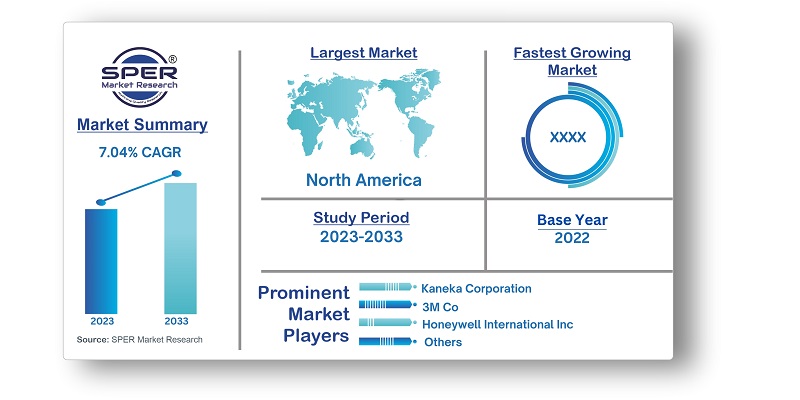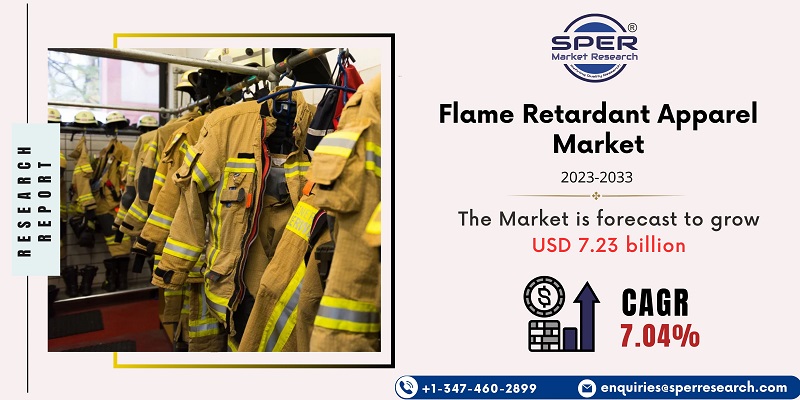
Flame Retardant Apparel Market Growth, Trends, Size, Demand, Revenue, Share and Future Outlook
Flame Retardant Apparel Market Size- By Product, By Application- Regional Outlook, Competitive Strategies and Segment Forecast to 2033
| Published: Nov-2023 | Report ID: FMCG23114 | Pages: 1 - 224 | Formats*: |
| Category : Consumer & Retail | |||
- Lakeland Industries, Inc., a protective apparel manufacturer based in the United States, has recently announced a partnership with Amazon.com for product sales and delivery as part of the company's e-commerce program.


| Report Metric | Details |
| Market size available for years | 2019-2033 |
| Base year considered | 2022 |
| Forecast period | 2023-2033 |
| Segments covered | By Product, By Application |
| Regions covered | North America, Asia-Pacific, Latin America, Middle East & Africa and Europe |
| Companies Covered | Kaneka Corporation, 3M Co., Honeywell International Inc, Kimberly-Clark Corp, Ansell Ltd., Lakeland Industries Inc, Cintas Corp, Eagle Technical Products Ltd, VF Corp, Carhartt Inc., Williamson-Dickie Mfg. Co., National Safety Apparel, DuPont de Nemours Inc. |
- Industrial Workers
- Firefighters
- First Responders
- Military and Defense Personnel
- Oil and Gas Industry
- Chemical Industry Professionals
- Construction Workers
- Electrical Workers
- Mining Industry Personnel
| By Product: |
|
| By Application: |
|
- Global Flame Retardant Apparel Market Size (FY’2023-FY’2033)
- Overview of Global Flame Retardant Apparel Market
- Segmentation of Global Flame Retardant Apparel Market By Product (Shirt, FRC Coveralls, Pants, Others)
- Segmentation of Global Flame Retardant Apparel Market By Application (Chemical Industry, Pharmaceutical Industry, Pulp & Paper Industry, Food Processing Industry, Paint Industry, Others)
- Statistical Snap of Global Flame Retardant Apparel Market
- Expansion Analysis of Global Flame Retardant Apparel Market
- Problems and Obstacles in Global Flame Retardant Apparel Market
- Competitive Landscape in the Global Flame Retardant Apparel Market
- Impact of COVID-19 and Demonetization on Global Flame Retardant Apparel Market
- Details on Current Investment in Global Flame Retardant Apparel Market
- Competitive Analysis of Global Flame Retardant Apparel Market
- Prominent Players in the Global Flame Retardant Apparel Market
- SWOT Analysis of Global Flame Retardant Apparel Market
- Global Flame Retardant Apparel Market Future Outlook and Projections (FY’2023-FY’2033)
- Recommendations from Analyst
1.1. Scope of the report1.2. Market segment analysis
2.1. Research data source2.1.1. Secondary Data2.1.2. Primary Data2.1.3. SPER’s internal database2.1.4. Premium insight from KOL’s2.2. Market size estimation2.2.1. Top-down and Bottom-up approach2.3. Data triangulation
4.1. Driver, Restraint, Opportunity and Challenges analysis4.1.1. Drivers4.1.2. Restraints4.1.3. Opportunities4.1.4. Challenges4.2. COVID-19 Impacts of the Global Flame Retardant Apparel Market
5.1. SWOT Analysis5.1.1. Strengths5.1.2. Weaknesses5.1.3. Opportunities5.1.4. Threats5.2. PESTEL Analysis5.2.1. Political Landscape5.2.2. Economic Landscape5.2.3. Social Landscape5.2.4. Technological Landscape5.2.5. Environmental Landscape5.2.6. Legal Landscape5.3. PORTER’s Five Forces5.3.1. Bargaining power of suppliers5.3.2. Bargaining power of buyers5.3.3. Threat of Substitute5.3.4. Threat of new entrant5.3.5. Competitive rivalry5.4. Heat Map Analysis
6.1. Global Flame Retardant Apparel Market Manufacturing Base Distribution, Sales Area, Product Type6.2. Mergers & Acquisitions, Partnerships, Product Launch, and Collaboration in Global Flame Retardant Apparel Market
7.1. Global Flame Retardant Apparel Market Value Share and Forecast, By Product, 2023-20337.2. Shirt7.3. FRC Coveralls7.4. Pants7.5. Others
8.1. Global Flame Retardant Apparel Market Value Share and Forecast, By Application, 2023-20338.2. Chemical Industry8.3. Pharmaceutical Industry8.4. Pulp & Paper Industry8.5. Food Processing Industry8.6. Paint Industry8.7. Others
9.1. Global Flame Retardant Apparel Market Size and Market Share
10.1. Global Flame Retardant Apparel Market Size and Market Share By Product (2019-2026)10.2. Global Flame Retardant Apparel Market Size and Market Share By Product (2027-2033)
11.1. Global Flame Retardant Apparel Market Size and Market Share By Application (2019-2026)11.2. Global Flame Retardant Apparel Market Size and Market Share By Application (2027-2033)
12.1. Global Flame Retardant Apparel Market Size and Market Share By Region (2019-2026)12.2. Global Flame Retardant Apparel Market Size and Market Share By Region (2027-2033)12.3. Asia-Pacific12.3.1. Australia12.3.2. China12.3.3. India12.3.4. Japan12.3.5. South Korea12.3.6. Rest of Asia-Pacific12.4. Europe12.4.1. France12.4.2. Germany12.4.3. Italy12.4.4. Spain12.4.5. United Kingdom12.4.6. Rest of Europe12.5. Middle East and Africa12.5.1. Kingdom of Saudi Arabia12.5.2. United Arab Emirates12.5.3. Rest of Middle East & Africa12.6. North America12.6.1. Canada12.6.2. Mexico12.6.3. United States12.7. Latin America12.7.1. Argentina12.7.2. Brazil12.7.3. Rest of Latin America
13.1. 3M Co13.1.1. Company details13.1.2. Financial outlook13.1.3. Product summary13.1.4. Recent developments13.2. Carhartt Inc13.2.1. Company details13.2.2. Financial outlook13.2.3. Product summary13.2.4. Recent developments13.3. Cintas Cor13.3.1. Company details13.3.2. Financial outlook13.3.3. Product summary13.3.4. Recent developments13.4. DuPont de Nemours13.4.1. Company details13.4.2. Financial outlook13.4.3. Product summary13.4.4. Recent developments13.5. Eagle Technical Products Ltd13.5.1. Company details13.5.2. Financial outlook13.5.3. Product summary13.5.4. Recent developments13.6. Honeywell International Inc,13.6.1. Company details13.6.2. Financial outlook13.6.3. Product summary13.6.4. Recent developments13.7. Kimberly-Clark Corp13.7.1. Company details13.7.2. Financial outlook13.7.3. Product summary13.7.4. Recent developments13.8. Ansell Ltd13.8.1. Company details13.8.2. Financial outlook13.8.3. Product summary13.8.4. Recent developments13.9. Kaneka Corporation13.9.1. Company details13.9.2. Financial outlook13.9.3. Product summary13.9.4. Recent developments13.10. Lakeland Industries Inc13.10.1. Company details13.10.2. Financial outlook13.10.3. Product summary13.10.4. Recent developments13.11. VF Corp13.11.1. Company details13.11.2. Financial outlook13.11.3. Product summary13.11.4. Recent developments13.12. Williamson-Dickie Mfg. Co13.12.1. Company details13.12.2. Financial outlook13.12.3. Product summary13.12.4. Recent developments13.13. Others
SPER Market Research’s methodology uses great emphasis on primary research to ensure that the market intelligence insights are up to date, reliable and accurate. Primary interviews are done with players involved in each phase of a supply chain to analyze the market forecasting. The secondary research method is used to help you fully understand how the future markets and the spending patterns look likes.
The report is based on in-depth qualitative and quantitative analysis of the Product Market. The quantitative analysis involves the application of various projection and sampling techniques. The qualitative analysis involves primary interviews, surveys, and vendor briefings. The data gathered as a result of these processes are validated through experts opinion. Our research methodology entails an ideal mixture of primary and secondary initiatives.



Frequently Asked Questions About This Report
PLACE AN ORDER
Year End Discount
Sample Report
Pre-Purchase Inquiry
NEED CUSTOMIZATION?
Request CustomizationCALL OR EMAIL US
100% Secure Payment






Related Reports
Our Global Clients
Our data-driven insights have influenced the strategy of 200+ reputed companies across the globe.






















